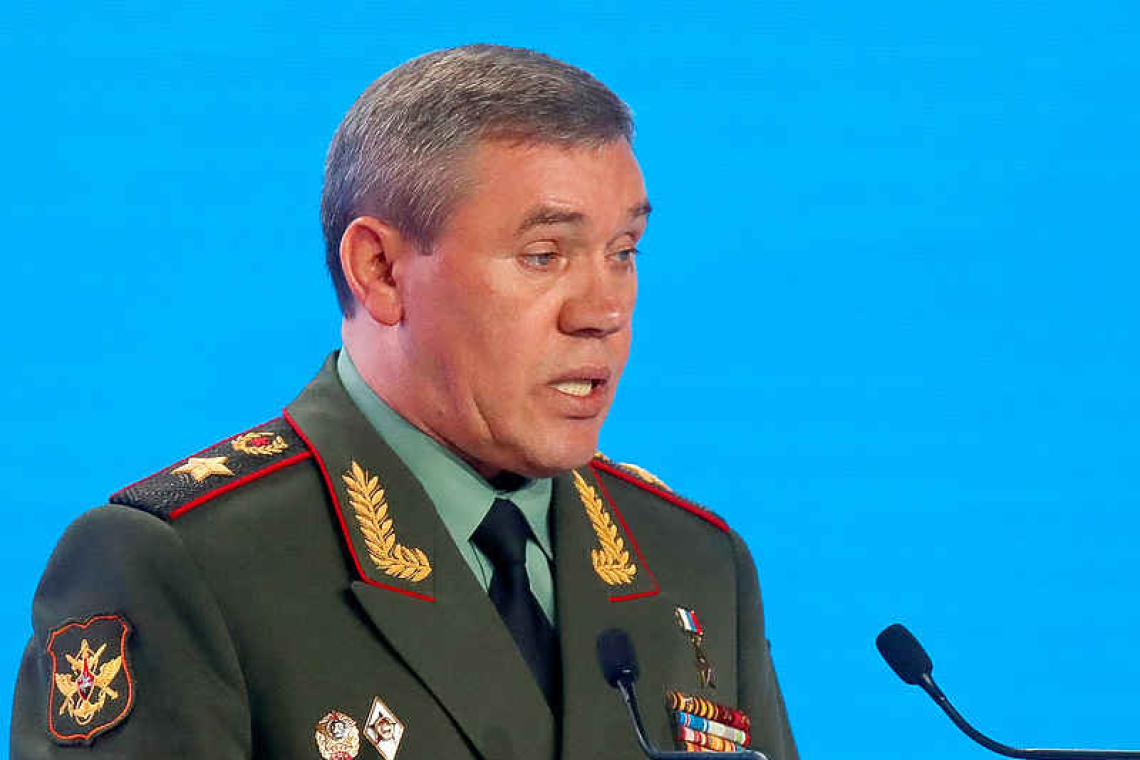Chief of the General Staff of Russian Armed Forces Valery Gerasimov.
WASHINGTON--A communications line created between the militaries of the United States and Russia at the start of Moscow's war against Ukraine has been used only once so far, a U.S. official told Reuters.
The official, who spoke on condition of anonymity, said that the United States initiated a call through the "deconfliction" line to communicate its concerns about Russian military operations near critical infrastructure in Ukraine. Reuters is the first to report on the use of the deconfliction line, beyond regular testing.
Few details are known surrounding the specific incident that led to the call on the line, which connects the U.S. military's European Command and Russia's National Defense Management Center.
The official declined to elaborate but said it was not used when an errant missile landed in NATO-member Poland on Nov. 15, killing two people. The blast was likely caused by a Ukrainian air defense missile but Russia was ultimately responsible because it started the war in late February, NATO said.
Although the U.S. official declined to specify which Russian activity raised the U.S. alarm, there have been publicly acknowledged incidents involving Russian fighting around critical Ukrainian infrastructure. These include Russian operations around Ukraine's Zaporizhzhia nuclear power plant, Europe's biggest, which is under Russian control.
Ukraine has also voiced concerns Russia might blow up the Nova Kakhovka dam, which holds back an enormous reservoir in southern Ukraine. Bursting the dam would send a wall of water flooding settlements below, including towards the strategic regional capital Kherson, which Ukrainian forces recaptured on Nov. 11.
U.S.-Russia communications have been in the spotlight since the start of Russia's invasion of its neighbour, given the grave risk that a miscalculation by either side could cause a direct conflict between the nuclear-armed nations.
The deconfliction line is just one of several ways the U.S. and Russia militaries still have to communicate. Other military channels include rare high-level talks between U.S. Defense Secretary Lloyd Austin and Russian Defense Minister Sergei Shoigu. The top U.S. and Russian generals, U.S. Army General Mark Milley and Russian General Valery Gerasimov, have also spoken on two occasions since the war started, his office said.
White House national security adviser Jake Sullivan and CIA Director Bill Burns have also had contact with Russian officials. Still, U.S.-Russia relations are at their lowest point since the Cold War and the U.S. State Department said on Monday that Moscow postponed talks in Cairo aimed at resuming nuclear weapons inspections. The Russian foreign ministry confirmed the talks were postponed. Neither side provided a reason.
Asked for comment on the deconfliction line, the Pentagon said only that it retained several channels to "discuss critical security issues with the Russians during a contingency or emergency for the purposes of preventing miscalculation, military incidents, and escalation."
"We are encouraged by recent senior DoD calls with Russian counterparts and believe continued dialogue is critical," a Department of Defense spokesperson said.
Neither Russia's embassy in Washington nor its defense ministry in Moscow responded to requests for comment.
When it was announced in March, the Pentagon said the deconfliction line was created to avoid any inadvertent clashes in NATO airspace or on the ground. "It's not meant to be an all-purpose complaint line where we can just pick up the phone and register concerns about what Russia's doing in Ukraine," a senior U.S. defense official said at the time.
During the Cold War, the United States and the Soviet Union maintained such hot lines at different levels. Alexander Vershbow, a former U.S. ambassador to Moscow and a former senior Pentagon and NATO official, said the latest deconfliction line was meant to focus on daily operations - as opposed to the more strategic conversations between top officials like Milley and Gerasimov.
Vershbow drew a comparison to the far more active deconfliction line for Syria, where U.S. and Russian military forces sometimes operate in the same airspace or terrain. "We've seen this in Syria, where having the direct operational channel can at least clarify intentions during a fast-moving situation where maybe Washington is asleep," Vershbow told Reuters.
The deconfliction line is tested twice daily with calls conducted in Russian, the U.S. official told Reuters. A Russian speaker from the U.S. European Command initiates those calls out of Wiesbaden, Germany, the official said.







